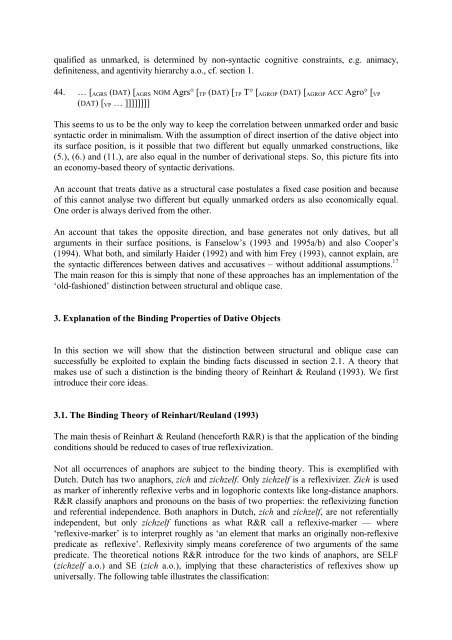The Dative – an Oblique Case
The Dative – an Oblique Case
The Dative – an Oblique Case
You also want an ePaper? Increase the reach of your titles
YUMPU automatically turns print PDFs into web optimized ePapers that Google loves.
qualified as unmarked, is determined by non-syntactic cognitive constraints, e.g. <strong>an</strong>imacy,<br />
definiteness, <strong>an</strong>d agentivity hierarchy a.o., cf. section 1.<br />
44. … [AGRS (DAT) [AGRS NOM Agrs° [TP (DAT) [TP T° [AGROP (DAT) [AGROP ACC Agro° [VP<br />
(DAT) [VP … ]]]]]]]]<br />
This seems to us to be the only way to keep the correlation between unmarked order <strong>an</strong>d basic<br />
syntactic order in minimalism. With the assumption of direct insertion of the dative object into<br />
its surface position, is it possible that two different but equally unmarked constructions, like<br />
(5.), (6.) <strong>an</strong>d (11.), are also equal in the number of derivational steps. So, this picture fits into<br />
<strong>an</strong> economy-based theory of syntactic derivations.<br />
An account that treats dative as a structural case postulates a fixed case position <strong>an</strong>d because<br />
of this c<strong>an</strong>not <strong>an</strong>alyse two different but equally unmarked orders as also economically equal.<br />
One order is always derived from the other.<br />
An account that takes the opposite direction, <strong>an</strong>d base generates not only datives, but all<br />
arguments in their surface positions, is F<strong>an</strong>selow’s (1993 <strong>an</strong>d 1995a/b) <strong>an</strong>d also Cooper’s<br />
(1994). What both, <strong>an</strong>d similarly Haider (1992) <strong>an</strong>d with him Frey (1993), c<strong>an</strong>not explain, are<br />
the syntactic differences between datives <strong>an</strong>d accusatives <strong>–</strong> without additional assumptions. 17<br />
<strong>The</strong> main reason for this is simply that none of these approaches has <strong>an</strong> implementation of the<br />
‘old-fashioned’ distinction between structural <strong>an</strong>d oblique case.<br />
3. Expl<strong>an</strong>ation of the Binding Properties of <strong>Dative</strong> Objects<br />
In this section we will show that the distinction between structural <strong>an</strong>d oblique case c<strong>an</strong><br />
successfully be exploited to explain the binding facts discussed in section 2.1. A theory that<br />
makes use of such a distinction is the binding theory of Reinhart & Reul<strong>an</strong>d (1993). We first<br />
introduce their core ideas.<br />
3.1. <strong>The</strong> Binding <strong>The</strong>ory of Reinhart/Reul<strong>an</strong>d (1993)<br />
<strong>The</strong> main thesis of Reinhart & Reul<strong>an</strong>d (henceforth R&R) is that the application of the binding<br />
conditions should be reduced to cases of true reflexivization.<br />
Not all occurrences of <strong>an</strong>aphors are subject to the binding theory. This is exemplified with<br />
Dutch. Dutch has two <strong>an</strong>aphors, zich <strong>an</strong>d zichzelf. Only zichzelf is a reflexivizer. Zich is used<br />
as marker of inherently reflexive verbs <strong>an</strong>d in logophoric contexts like long-dist<strong>an</strong>ce <strong>an</strong>aphors.<br />
R&R classify <strong>an</strong>aphors <strong>an</strong>d pronouns on the basis of two properties: the reflexivizing function<br />
<strong>an</strong>d referential independence. Both <strong>an</strong>aphors in Dutch, zich <strong>an</strong>d zichzelf, are not referentially<br />
independent, but only zichzelf functions as what R&R call a reflexive-marker — where<br />
‘reflexive-marker’ is to interpret roughly as ‘<strong>an</strong> element that marks <strong>an</strong> originally non-reflexive<br />
predicate as reflexive’. Reflexivity simply me<strong>an</strong>s coreference of two arguments of the same<br />
predicate. <strong>The</strong> theoretical notions R&R introduce for the two kinds of <strong>an</strong>aphors, are SELF<br />
(zichzelf a.o.) <strong>an</strong>d SE (zich a.o.), implying that these characteristics of reflexives show up<br />
universally. <strong>The</strong> following table illustrates the classification:

















